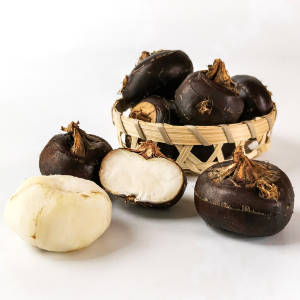Other Tubers & Corms Category

Varieties:
arracacha
These come from South America. According to the FAO, they taste like a cross between celery, cabbage, and chestnuts.
Learn morearrowroot
The name arrowroot is more commonly associated with a thickener that's made from the plant. A fresh arrowroot tuber looks like a small onion, only without the layers. It should be peeled, and then it can be boiled or stir-fried. Look for it in Chinese markets during the winter.
Learn morecassava
People in Hispanic countries use cassavas much like Americans use potatoes. There's both a sweet and a bitter variety of cassava. The sweet one can be eaten raw, but the bitter one requires cooking to destroy the harmful prussic acid it contains. It's often best to buy frozen cassava, since the fresh kind is hard to peel. Look for it in Hispanic markets. It doesn't store well, so use it within a day or two of purchase.
Learn moreChinese artichoke
These look a bit like caterpillars, and they taste like Jerusalem artichokes. They're popular in France but hard to find in the U.S. Your best bet would be an Asian market.
Learn moreJerusalem artichoke
These look like small, knobby potatoes, but they have a crisp texture and an interesting earthy flavor. You can eat them raw, stir-fry them, or bake them like potatoes. It's best not to peel them, but you'll want to scrub off the dirt. If you slice them, dunk them immediately in acidulated water to keep them from discoloring.
Learn morejicama
This tan-skinned tuber has a mild, nondescript flavor, but a nice crunchy texture. It's a good, cheap substitute for water chestnuts in stir-fries. Since it doesn't discolor, it's also a great vegetable to serve raw on a crudité platter. Peel it before using.
Learn moremalanga
Like taro and cassava, malanga is used in tropical countries in much the same way that potatoes are used in more temperate climates.
Learn moretaro
If you've sampled poi at a Hawaiian luau, then you're already familiar with taro. Many people don't think much of poi, but taro can be served far more advantageously. It has an interesting, nutty flavor, and it's quite good in stews or soups, or deep-fat fried or roasted. In its raw state, it can be toxic and harsh on the skin, so wear gloves or oil your hands when handling it, and always cook it before serving it.
Learn morewater chestnut
Water chestnuts are delightfully sweet and crisp--if you buy them fresh. Though canned water chestnuts are more easily available, they're not nearly as good. Look for fresh water chestnuts in Asian markets. You need to peel off their brown jackets and simmer them for five minutes before stir-frying. If you must use canned water chestnuts, blanch them first in boiling water for thirty seconds.
Learn more









































































































































































































































































































































